中国文化符号(英语)
- 格式:pptx
- 大小:2.44 MB
- 文档页数:93
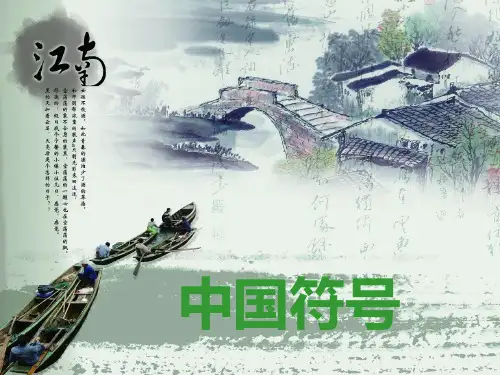
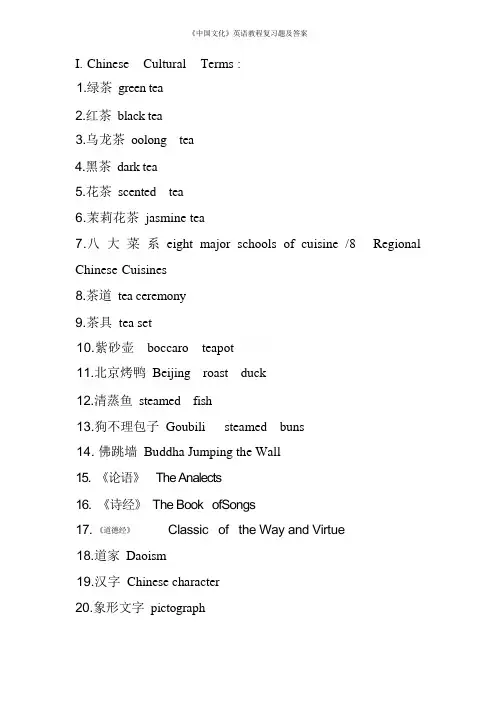
I. Chinese Cultural Terms :1.绿茶green tea2.红茶black tea3.乌龙茶oolong tea4.黑茶dark tea5.花茶scented tea6.茉莉花茶jasmine tea7.八大菜系eight major schools of cuisine /8 Regional Chinese Cuisines8.茶道tea ceremony9.茶具tea set10.紫砂壶boccaro teapot11.北京烤鸭Beijing roast duck12.清蒸鱼steamed fish13.狗不理包子Goubili steamed buns14. 佛跳墙Buddha Jumping the Wall15. 《论语》The Analects16. 《诗经》The Book ofSongs17. 《道德经》Classic of the Way and Virtue18.道家Daoism19.汉字Chinese character20.象形文字pictograph21.甲骨文oracle-bone inscription/ oracle-bone script22.篆文seal character/ seal script23.文房四宝four treasures of study24.丝绸之路the Silk Road25. 海上丝绸之路the Maritime silk road26.一带一路倡议The Belt and Road Initiative27.西域the Western regions28.敦煌石窟the Dunhuang Grottoes29.春秋时期the Spring and Autumn Period30. 方块象形文字the square-shaped pictographic character31. 颜(真卿)体the Yan style32. 民间艺术folk arts33.年画New Year pictures34.剪纸paper cutting /papercuts35.皮影戏shadow play36.苏绣Suhou Embroidery37.造纸术paper making38.印刷术printing39.佛经Buddhist scripture40.行书running script /semi-cursive script41.草书cursive script42.楷书regular script/standard script43.隶书official script/ clerical script44.砚the ink slab/ the ink stone; 墨ink stick45.六艺:礼乐射御书数“six arts” : ritual,music,archery, carriage driving , calligraphy , and mathematics46.毛笔the writing brush47.宣纸xuan paper/ rice paper48.中国书法Chinese calligraphy49.简体字:simplified characters50. 繁体字complex characters/ traditional characters51.中国结Chinese knots52.佛教Buddhism53.国徽national emblem54. 国旗national flag55. 国歌national anthemII. Multiple choices (每题三个选项中选一个最佳答案)1)Which of the following is irrelevant to the pictographic symbols of Chinese characters? (下列哪项与汉字的象形符号无关?)Aspiration. 吸Imagination.想象Creativity.创造力Allusion.典故2) Which of the following statements is true of the name of Fudan Universit(y关于复旦大学的名称,下列哪个陈述是正确的?)The characters both stand for "the sun rising on the horizon"这.些字符都代表着“太阳在地平线上升起”The name is taken from a Chinese classical poem.这个名字取自中国古典诗歌The name encourages the students to get up early in the morning.这个名字鼓励学生早上早起The characters are intended to tell the students to make progress day by day.这些字旨在让学生们一天天地进步3) Which of the following languages mostly consists of language pictures(下列语言中哪一种主要由语言图片组成?) ? B___Mandarin Chinese. 普通话Hieroglyphs of ancient Egypt.古埃及的象形文字Oracle-bone inscription. 甲骨文Seal characters.篆书4) The symbol for “swimming” is closest to (“游泳”的符号最接近的是)oracle-bone inscription 甲骨文Mandarin Chinese 普通话seal characters 篆书none of the above 没有选项5)The symbol for “athletics” contains the ingredients of (“运动”的符号包含了)dancing and running 跳舞、跑步running and swinging 跑步和摆动dancing and swinging 跳舞和摆动triathlon and football 铁人三项和足球6)All the following are the titles of Confucius excep(t以下孔子的头衔除了) ___.Ban educator 一个教育家A biologist 一个生物学家A scholar 有识之士A philosopher 一个哲学家7)The expression “filial piety” most probably means being (“孝”的意思很可能是指) ___.DLoyal to the state 忠于国家Obedient to sister(s) 听姐姐的话Responsible for the family 对家庭负责Dutiful to parents 孝顺父母8)Which of following can best describe Confucius’ view on the relationship between man and nature (下面哪一个最能说明孔子对人与自然关系的看法?) ___.D Brothers 兄弟Husband and wife 夫妇Doctor and patient 医生和病人Mother and son 母子9)Through burial and ancestral worship rituals,people can learn that (通过丧葬和祭祖仪式,人们可以了解到。
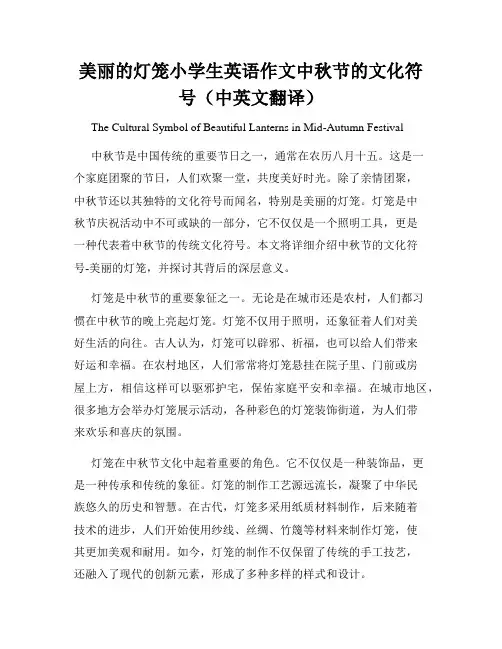
美丽的灯笼小学生英语作文中秋节的文化符号(中英文翻译)The Cultural Symbol of Beautiful Lanterns in Mid-Autumn Festival中秋节是中国传统的重要节日之一,通常在农历八月十五。
这是一个家庭团聚的节日,人们欢聚一堂,共度美好时光。
除了亲情团聚,中秋节还以其独特的文化符号而闻名,特别是美丽的灯笼。
灯笼是中秋节庆祝活动中不可或缺的一部分,它不仅仅是一个照明工具,更是一种代表着中秋节的传统文化符号。
本文将详细介绍中秋节的文化符号-美丽的灯笼,并探讨其背后的深层意义。
灯笼是中秋节的重要象征之一。
无论是在城市还是农村,人们都习惯在中秋节的晚上亮起灯笼。
灯笼不仅用于照明,还象征着人们对美好生活的向往。
古人认为,灯笼可以辟邪、祈福,也可以给人们带来好运和幸福。
在农村地区,人们常常将灯笼悬挂在院子里、门前或房屋上方,相信这样可以驱邪护宅,保佑家庭平安和幸福。
在城市地区,很多地方会举办灯笼展示活动,各种彩色的灯笼装饰街道,为人们带来欢乐和喜庆的氛围。
灯笼在中秋节文化中起着重要的角色。
它不仅仅是一种装饰品,更是一种传承和传统的象征。
灯笼的制作工艺源远流长,凝聚了中华民族悠久的历史和智慧。
在古代,灯笼多采用纸质材料制作,后来随着技术的进步,人们开始使用纱线、丝绸、竹篾等材料来制作灯笼,使其更加美观和耐用。
如今,灯笼的制作不仅保留了传统的手工技艺,还融入了现代的创新元素,形成了多种多样的样式和设计。
在中秋节期间,孩子们常常参与制作和装饰灯笼的活动。
他们可以在学校或家里动手制作灯笼,体验到传统文化的魅力。
这不仅有助于培养孩子们的创造力和动手能力,还加深了他们对中秋节文化的了解和认识。
同时,孩子们还可以亲自挑选自己钟爱的灯笼,在中秋节晚上参加灯笼游行,与朋友们一起分享快乐和童真。
灯笼作为中秋节的文化符号,也在国际间享有盛誉。
中国的灯笼制作技艺已经被列入联合国非物质文化遗产代表作名录,成为世界上重要的非物质文化遗产。
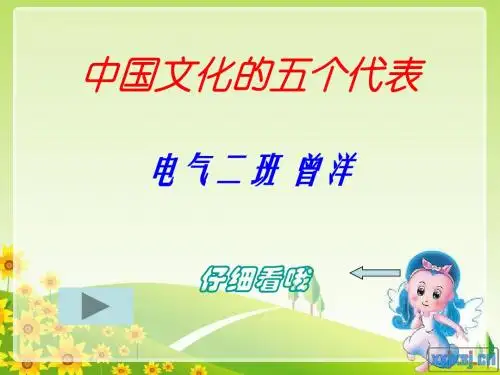
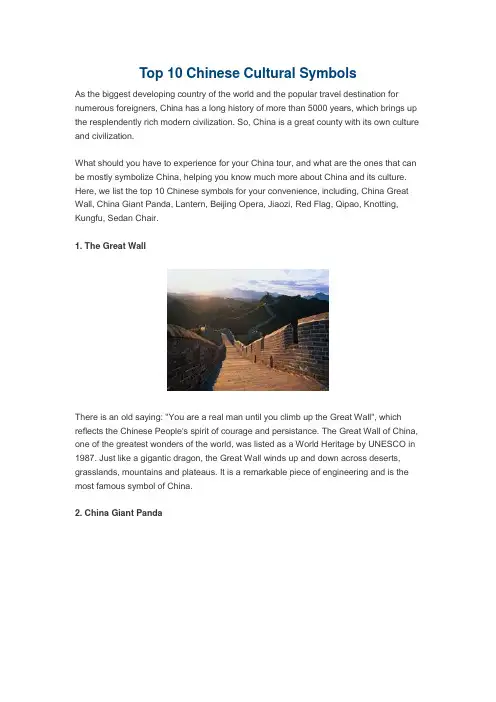
Top 10 Chinese Cultural SymbolsAs the biggest developing country of the world and the popular travel destination for numerous foreigners, China has a long history of more than 5000 years, which brings up the resplendently rich modern civilization. So, China is a great county with its own culture and civilization.What should you have to experience for your China tour, and what are the ones that can be mostly symbolize China, helping you know much more about China and its culture. Here, we list the top 10 Chinese symbols for your convenience, including, China Great Wall, China Giant Panda, Lantern, Beijing Opera, Jiaozi, Red Flag, Qipao, Knotting, Kungfu, Sedan Chair.1. The Great WallThere is an old saying: "You are a real man until you climb up the Great Wall", which reflects the Chinese People's spirit of courage and persistance. The Great Wall of China, one of the greatest wonders of the world, was listed as a World Heritage by UNESCO in 1987. Just like a gigantic dragon, the Great Wall winds up and down across deserts, grasslands, mountains and plateaus. It is a remarkable piece of engineering and is the most famous symbol of China.2. China Giant PandaThe giant panda, regarded as one of China's National Treasures, is on the verge of extinction. Today there are fewer than 1,000 giant pandas living in the world. The giant panda is the symbol of eco-environmental conservation. Visitors to China can see this reclusive animal in Sichuan Province's Chengdu Research Base of Giant Panda Breeding. We hope, with their cute faces, unusual beauty and grace, giant pandas can bring visitors to China pleasure and enjoyment.3. Chinese LanternLanterns play an important and irreplaceable role in Chinese long history and symbolize the brilliant culture of China. The art of lanterns, as the precious traditional culture of Chinese, is also inherited and continues among folks.The craftwork of lantern is still widely used in current society which can be seen in some happy days such as the Lantern Festival, wedding and celebration ceremonies. Besides, lanterns have some other functions in daily life. For example, at ancient time, when there was no electricity, lanterns were used as a tool of illumination, which brought great convenience to everyday life.4. Beijing Opera (Bianlian)Beijing Opera is the quintessence of China. As the largest Chinese opera form, it is extolled as 'Oriental Opera'. Having a history of 160 years, it has created many 'firsts' in Chinese dramas: the abundance of repertoires, the number of artists, opera troupes and spectators.The costumes in Beijing Opera are graceful, magnificent, elegant and brilliant, and mostly are made in handicraft embroidery. As the traditional Chinese pattern are adopted, the costumes are of a high aesthetic value.The types of facial make-ups in Beijing Opera are rich and various, depicting different characters and remarkable images, therefore they are highly appreciated. Moreover there are numerous fixed editions of facial make-up.5. Chinese JiaoziJiaozi (Chinese Dumpling) is a traditional Chinese food, and is greatly loved by most foreigners.Dumplings are one of the major foods eaten during the Chinese New Year, and year round in the northern provinces. Traditionally, families get together to make jiaozi for the Chinese New Year. In rural areas, the choicest livestock is slaughtered, the meat ground and wrapped into dumplings, and frozen outside with the help of the freezing weather. Then they are boiled and served for the Chinese New Year feast. Dumplings with sweet, rather than savoury fillings are also popular as a Chinese New Year treat.6. Chinese Red FlagThe flag of the People's Republic of China is a red field charged in the canton with five golden stars. The design features one large star, with four smaller stars in a semicircle set off towards the fly. The red represents revolution; the five stars and their relationship represents the unity of the Chinese people under the leadership of Communist Party of China (CPC). Sometimes, the flag is referred to as the "Five Star Red Flag".7. Chinese QipaoThe cheongsam is a female dress with distinctive Chinese features and enjoys a growing popularity in the international world of high fashion. The name "cheongsam," meaning simply "long dress," entered the English vocabulary from the dialect of China's Guangdong Province (Cantonese). In other parts of the country including Beijing, however, it is known as "qipao", which has a history behind it.8. Chinese KnottingChinese knotting is a decorative handicraft arts that began as a form of Chinese folk art in the Tang and Song Dynasty (960-1279 AD) in China. It was later popularized in the Ming and Qing Dynasty (1368-1911 AD). The art is also referred to as Chinese traditional decorative knots. In other cultures, it is known as "Decorative knots".In February 2008, Corra Liew from Malaysia seek possibilities out from the traditional Wire Jewelry Making technique, Chinese knotting is then merged and presented in wire form. Corra addressed the technique as Wired Chinese Knot.9. Chinese KungfuKung fu and wushu are popular terms that have become synonymous with Chinese martial arts. However, the Chinese terms kung fu and wushu have very different meanings. The Chinese literal equivalent of "Chinese martial art" would be zhongguo wushu.In Chinese, kung fu can be used in contexts completely unrelated to martial arts, and refers colloquially to any individual accomplishment or skill cultivated through long and hard work. In contrast, wushu is a more precise term for general martial activities.10. Chinese Sedan ChairA sedan chair is a human or animal-powered transport vehicle for carrying a person, once popular across China. It has different names like "shoulder carriage", "sleeping sedan" and "warm sedan" etc due to the time, location and structural differences. The sedans familiar to modern people are warm sedans that have been in use since the Ming and Qing Dynasties. The sedan body is fixed in the wooden rectangular frames on the two thin log poles. The top and four sides of the seat are enclosed with curtains, with a chair blind that could be rolled open in the front and a small window on each side. A chair is placed inside the enclosed space.。
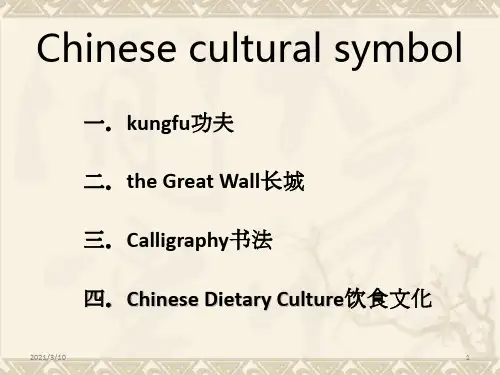
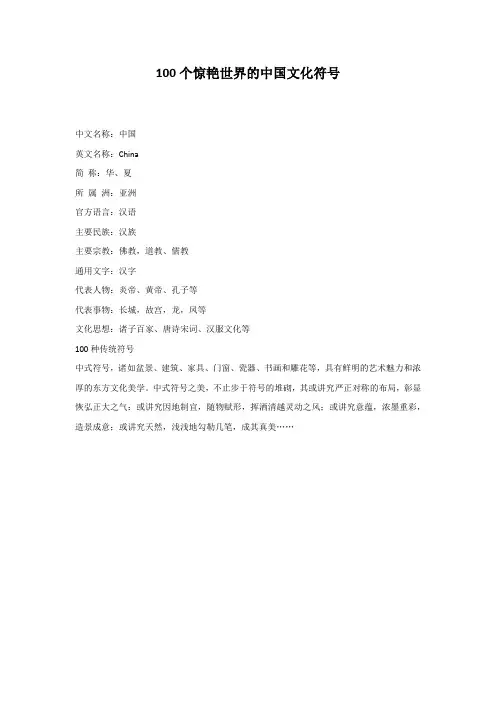
100个惊艳世界的中国文化符号中文名称:中国英文名称:China简称:华、夏所属洲:亚洲官方语言:汉语主要民族:汉族主要宗教:佛教,道教、儒教通用文字:汉字代表人物:炎帝、黄帝、孔子等代表事物:长城,故宫,龙,凤等文化思想:诸子百家、唐诗宋词、汉服文化等100种传统符号中式符号,诸如盆景、建筑、家具、门窗、瓷器、书画和雕花等,具有鲜明的艺术魅力和浓厚的东方文化美学。
中式符号之美,不止步于符号的堆砌,其或讲究严正对称的布局,彰显恢弘正大之气:或讲究因地制宜,随物赋形,挥洒清越灵动之风;或讲究意蕴,浓墨重彩,造景成意;或讲究天然,浅浅地勾勒几笔,成其真美……1、中国盆景艺术中国盆景是大自然景物的缩影,是集园林栽培、文学、绘画等艺术,互相结合,溶为一体的综合性造型艺术,是富有自然情趣的东方艺术精品之一,也是我国独特的传统园林艺术之一。
2、中国国画国画,即中国画,是我国传统造型艺术之一。
在创作上重视构思,讲求意在笔先和形象思维,注重艺术形象的主客观统一。
造型上不拘于表面的肖似,而讲求“妙在似与不似之间”和“不似之似”。
其形象的塑造以能传达出物象的神态情韵和画家的主观情感为要旨。
3、中国书法中国书法是一门古老的汉字的书写艺术,被誉为“无言的诗,无行的舞;无图的画,无声的乐”等。
4、中国篆刻篆刻艺术,是书法(主要是篆书)和镌刻(包括凿、铸)结合,来制作印章的艺术,是汉字特有的艺术形式。
篆刻是一门综合性很强的艺术,直溯文字渊源,旁通书、画之理,与其姊妹艺术有着千丝万缕的联系,又兼涉镌刻技艺,内含人品性格和文学修养,从里到外都散发着强烈的艺术感染力。
5、中国结中国结是一种中国特有的手工编织工艺品,它身上所显示的情致与智慧正是中华古老文明中的一个侧面,以其独特的东方神韵、丰富多彩的变化,充分体现了中国人民的智慧和深厚的文化底蕴。
6、戏曲中国戏曲主要是由民间歌舞、说唱和滑稽戏三种不同艺术形式综合而成,凝聚着中国传统文化的美学思想精髓,构成了独特的戏剧观,在世界戏曲文化的大舞台上闪耀着它独特的艺术光辉。
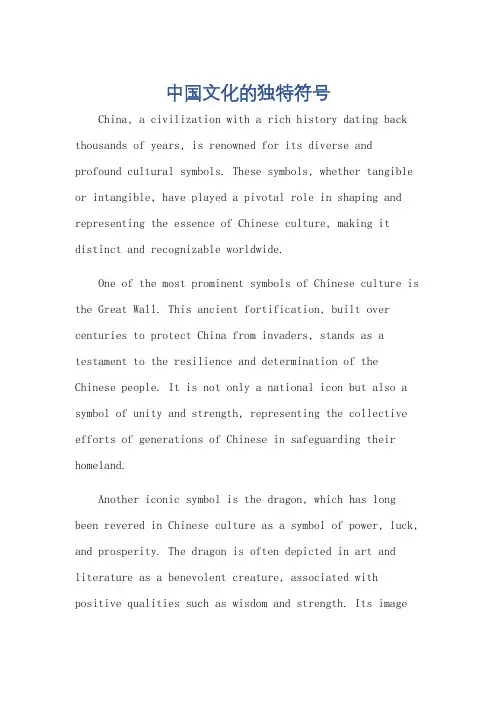
中国文化的独特符号China, a civilization with a rich history dating back thousands of years, is renowned for its diverse and profound cultural symbols. These symbols, whether tangible or intangible, have played a pivotal role in shaping and representing the essence of Chinese culture, making it distinct and recognizable worldwide.One of the most prominent symbols of Chinese culture is the Great Wall. This ancient fortification, built over centuries to protect China from invaders, stands as a testament to the resilience and determination of the Chinese people. It is not only a national icon but also a symbol of unity and strength, representing the collective efforts of generations of Chinese in safeguarding their homeland.Another iconic symbol is the dragon, which has long been revered in Chinese culture as a symbol of power, luck, and prosperity. The dragon is often depicted in art and literature as a benevolent creature, associated with positive qualities such as wisdom and strength. Its imageis frequently used in festivals and celebrations, symbolizing good fortune and prosperity for the nation.Chinese calligraphy, an art form that involves writing characters with a brush and ink, is another essential symbol of Chinese culture. It is not only a means of communication but also an expression of aesthetics and creativity. Each stroke and curve in a character reflects the artist's skill and emotion, making calligraphy a unique and powerful form of artistic expression.Furthermore, Chinese traditional festivals are also important cultural symbols. The Spring Festival, or Chinese New Year, is the most celebrated holiday in China, filled with joy, reunion, and hope for a prosperous future. Other festivals like the Mid-Autumn Festival and the Dragon Boat Festival also have rich cultural meanings and traditions, representing different aspects of Chinese life and beliefs. These cultural symbols, along with many others such as Chinese tea culture, traditional music and dance, and architecture, form a unique and diverse tapestry that defines Chinese culture. They are not just representationsof the past but also carriers of values and traditions that continue to influence the lives of Chinese people today.In conclusion, the cultural symbols of China are not only reflections of its rich history and traditions but also powerful representations of its identity and spirit. They are the threads that bind the Chinese people together, connecting them to their ancestors and to each other, and also the bridges that connect China with the rest of the world, promoting cultural exchange and understanding. As China continues to develop and evolve, its cultural symbols will continue to play a crucial role in shaping itsidentity and influencing the world.**中国文化的独特符号**中国,这个拥有数千年丰富历史的文明古国,因其多样且深厚的文化符号而闻名于世。
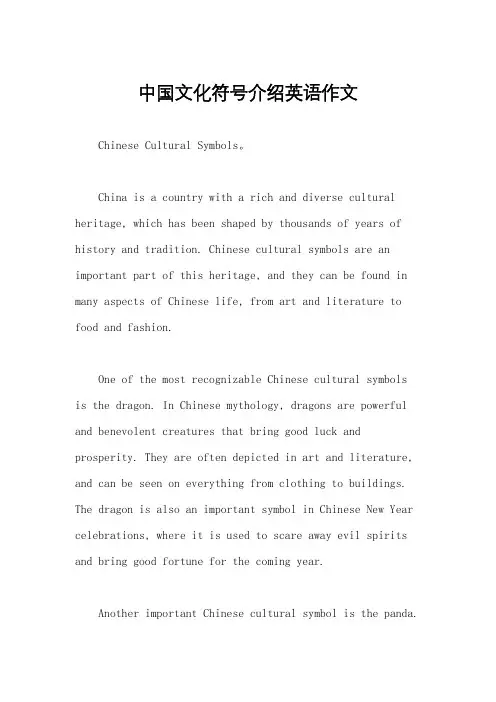
中国文化符号介绍英语作文Chinese Cultural Symbols。
China is a country with a rich and diverse cultural heritage, which has been shaped by thousands of years of history and tradition. Chinese cultural symbols are an important part of this heritage, and they can be found in many aspects of Chinese life, from art and literature to food and fashion.One of the most recognizable Chinese cultural symbolsis the dragon. In Chinese mythology, dragons are powerful and benevolent creatures that bring good luck and prosperity. They are often depicted in art and literature, and can be seen on everything from clothing to buildings. The dragon is also an important symbol in Chinese New Year celebrations, where it is used to scare away evil spirits and bring good fortune for the coming year.Another important Chinese cultural symbol is the panda.Pandas are native to China and are considered a national treasure. They are known for their cute and cuddly appearance, and are often used in marketing and advertising campaigns. The panda is also a symbol of peace and friendship, and is often given as a gift to foreign dignitaries.The Great Wall of China is another iconic Chinese cultural symbol. The wall was built over 2,000 years ago to protect China from invaders, and is now a popular tourist attraction. It is a symbol of China's strength and resilience, and is a testament to the ingenuity and determination of the Chinese people.Chinese calligraphy is also an important cultural symbol. Calligraphy is a form of writing that is highly valued in Chinese culture, and is often used in art and literature. It is considered a form of self-expression, and is seen as a way to connect with the spiritual world.Finally, Chinese cuisine is another important cultural symbol. Chinese food is known for its variety andcomplexity, and is enjoyed by people all over the world. It is a symbol of China's rich culinary heritage, and is an important part of Chinese culture.In conclusion, Chinese cultural symbols are an important part of China's rich and diverse heritage. They are a testament to the creativity and ingenuity of the Chinese people, and are an important part of Chinese life and culture. Whether it is the dragon, the panda, the Great Wall, calligraphy, or cuisine, these symbols are a source of pride and inspiration for the Chinese people, and will continue to be an important part of China's cultural identity for generations to come.。
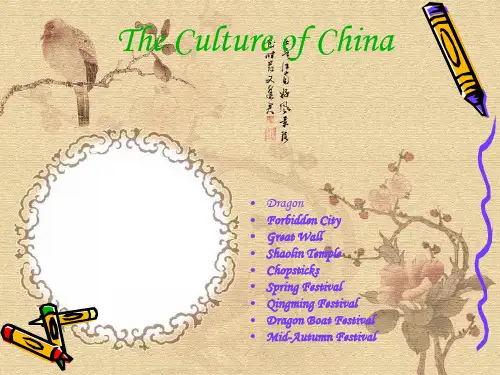
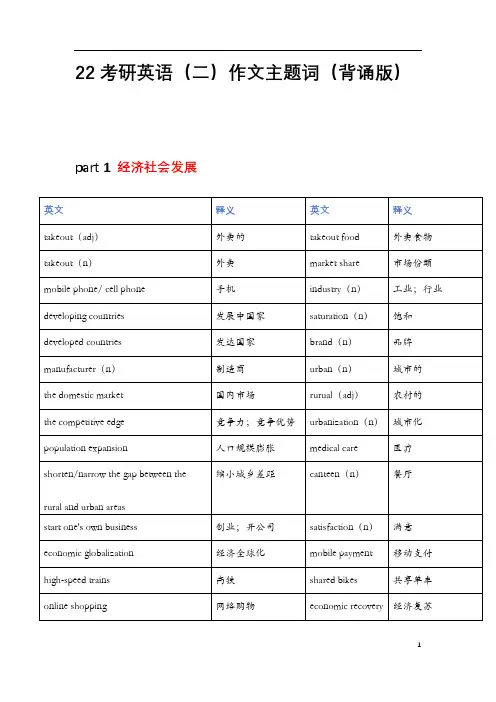
Chinese culture is a rich tapestry woven with thousands of years of history,philosophy,and artistic expression.Among the myriad elements that represent this ancient civilization,certain symbols stand out as emblematic of the cultural heritage and values that have shaped the Chinese identity over the centuries.The dragon,for instance,is a mythical creature that has captivated the Chinese imagination for millennia.Revered as a symbol of power,strength, and good fortune,the dragon is often depicted in vibrant red,a color that signifies joy and prosperity in Chinese culture.During festivals such as the Chinese New Year,dragon dances are performed with great enthusiasm, where a long,sinuous dragon figure is manipulated by a team of dancers to mimic the creatures movements.The sight of the dragon,with its undulating body and fiery eyes,is a spectacle that embodies the dynamism and vitality of Chinese culture.Another potent symbol is the phoenix,which is often paired with the dragon in Chinese art and mythology.The phoenix represents grace,virtue, and the yin aspect of the universe,complementing the dragons yang energy.Together,they symbolize a harmonious balance,a concept deeply rooted in Chinese philosophy.The phoenix is also associated with rebirth and renewal,as it is said to rise from the ashes,a metaphor for resilience and the cyclical nature of life.The Chinese character for Fu,which means blessing or happiness,is another emblematic symbol.It is commonly seen during the Spring Festival,adorning walls and doors in homes and public spaces.Thecharacter is often stylized with intricate designs and sometimes accompanied by images of children,symbolizing the hope for a prosperous and joyful year ahead.The act of pasting the Fu character is not just a decorative practice but a ritual that carries the weight of cultural significance and the collective aspirations of the people.Tea is not just a beverage in China it is a cultural practice that reflects the Chinese way of life.The art of tea,or cha dao,involves a ritualistic process of brewing and serving tea that emphasizes mindfulness,respect,and harmony.The tea ceremony is a reflection of the Chinese philosophy of living in tune with nature and the importance of taking time to appreciate the simple pleasures in life.The aroma of tea leaves steeping in hot water is a sensory experience that encapsulates the essence of Chinese culture.The Great Wall of China is a physical symbol that stands as a testament to the nations historical resilience and architectural prowess.Stretching over 13,000miles,the Great Wall is not just a defensive structure but a symbol of unity and perseverance.Its winding path across the diverse landscapes of China is a visual metaphor for the countrys enduring spirit and the collective effort of its people.In the realm of traditional Chinese medicine,the concept of Qi,or life energy,is a fundamental principle.The belief in the balance of Qi is reflected in practices such as acupuncture and tai chi,which aim to promote health and wellbeing by aligning the bodys energy flow with the natural world.The holistic approach to health and the emphasis on balance and harmony are indicative of the deep philosophicalunderpinnings of Chinese culture.The Chinese knot,with its intricate patterns and loops,is a symbol of unity, love,and good luck.Often used as a decorative element in clothing, jewelry,and home furnishings,the knot is a tangible representation of the interconnectedness of life and the complex relationships that bind people together.In conclusion,the symbols of Chinese culture are multifaceted and deeply symbolic,reflecting the rich history,philosophical depth,and artistic richness of this ancient civilization.From the mythical creatures of the dragon and phoenix to the practical wisdom of tea ceremonies and the Great Wall,these symbols are more than just images they are the living, breathing essence of a culture that has endured and flourished over thousands of years.。
最具代表性的中国文化符号排行榜收藏打印发给朋友举报来源:unknown发布者: webmaster热度0票【共 0条评论】【我要评论】时间: 2011年1月10日20:27第一项:汉语 ( 汉字)汉语: Chinese language汉字: Chinese character表达汉字为英文中的“character ”,与特征、特性是一个词,拿来代表中国似乎最合适不过了。
富有特色的汉语与汉字,可是让不少外国友人头疼不已呢!第二项:孔子孔子: Confucius孔子思想: Confucianism现在,世界各地都有孔子学院,教授中国古代的孔孟之道,孔子代表着中国的礼教,在世界范围内的影响都是巨大的。
第三项:书法书法: calligraphy书法、笔迹: penmanship这个与汉字有异曲同工之妙,甚至含义更加深刻,与中国古代的文人气节密切相关,中国人普遍相信“字如其人”。
第四项:长城长城: the Great Wall“不到长城非好汉”这句话很多外国友人都知道了,到了中国来也得爬一爬长城。
英语中用“Great”来形容长城,即表现长城的“长”也表达出了它“伟大”的意思。
第五项:五星红旗五星红旗: the Five-Starred Red Flag (the national flag of the People's Republic of China)五星红旗代表着中国,世界人民都知道它是中国的国旗.... 。
第六项:中医中医: traditional Chinese medical science现在,外国人越来越重视中医理论,在他们看来,中医即神秘又神奇,常常有意想不到的功效,因此被津津乐道。
甚至还有科学家企图用现代科技手段测量中医里的“脉络”。
第七项:毛泽东毛泽东: Mao Zedong,the founder of the People's Republic of China毛泽东是中华人民共和国的第一任主席,更是中国社会主义政治的核心代表人物,甚至是很多外国友人的偶像,世界各地都有人收藏毛泽东语录与像章。
The Symbols of Chinese CultureChina, a country with a rich and profound cultural heritage, is renowned for its diverse symbols that represent its unique traditions and values. These symbols, ranging from art and architecture to food and festivals, not only reflect the essence of Chinese culture but also serve as a bridge connecting the past with the present.One of the most iconic symbols of Chinese culture is the dragon. In Chinese mythology, the dragon is a powerful and auspicious creature that symbolizes good luck, prosperity, and strength. It is often depicted in art and architecture, appearing on everything from palace roofs to temple carvings. The dragon dance, a traditional performance during festivals and celebrations, is also a vibrant display of this symbolic creature.Another prominent symbol is the Chinese writing system, which has evolved over thousands of years. The intricate and beautiful characters, known as hanzi, are not only a means of communication but also a form of art. Calligraphy, the art of writing, is highly valued in Chinese culture and is considered a reflection of one's character and spirit.Chinese food is also a symbol of the country's rich culinary heritage. From the spicy Sichuan cuisine to the delicate Cantonese dishes, Chinese food is diverse and delicious. It often incorporates various flavors and techniques, reflecting the harmony and balance that are central to Chinese philosophy.Furthermore, the traditional festivals celebrated in China, such as the Spring Festival and the Mid-Autumn Festival, are also symbols of the country's cultural identity. These festivals are marked with specific customs and traditions, such as family reunions, dragon dances, and mooncake eating, that bring people together and celebrate the values of family, unity, and harmony.In conclusion, the symbols of Chinese culture are diverse and multifaceted, reflecting the country's rich historical and cultural background. From the dragon and the writing system to food and festivals, these symbols not only represent the unique traditions and values of China but also serve as a powerful reminder of the country's rich cultural heritage.。
40分阅读限时练阅读理解(共两节,满分40分)第一节(共15小题;每小题2分,满分30分)阅读下列短文,从每题所给的A、B、C和D四个选项中,选出最佳选项。
A[2019·兰州市模拟]Share Your Chinese Culture Emoji (表情符号) Designs and Win PrizesWhich symbol best represents Chinese culture in your eyes? Is it the panda, kung fu, or the Great Wall? Here's your chance to decide what emojis best represent Chinese culture! The China Daily Emoji Design Contest for Chinese Cultural Symbols is calling for entries from all over the world! No matter the style, share your creative ideas with us! All winning designs will be shared and promoted on the China Daily app, and winning designers will receive prizes! So let your creative juices flow!●ThemeThe emojis should be centered around the subject of Chinese culture, presenting classic or popular cultural images in the form of emojis.●Who can participate?Professional designersDesign enthusiastsAnybody who loves emojisAll nationalities are welcomed●AwardsFirst prize: 6,000 yuan, with a certificate of honorSecond prize: 3,000 yuan, with a certificate of honorThird prize: 1,000 yuan, with a certificate of honorThe most popular award: the prizewinner voted by online users●When to submit?From now till Nov. 25Online voting: Nov. 26 to Dec. 7●Result announcementThe end of December●Requirements1.Works should be submitted online with required personal information. Maximum of three works can be submitted by each applicant. Only one prize will be awarded to one participant even if more than onework by the same designer is selected.2.Submitted works must be a group, with 8 to 16 emojis in each group. Formats: jpg/png/gif/jpge. Size:240 × 240px. Each picture should not exceed (超过) 100K, and the size of each group should not exceed 1.6M.3.The work title, designing ideas and cultural meaning should be submitted as required.●OrganizerChina Daily Website体裁:应用文题材:广告主题:设计中国文化表情符号的参赛信息【语篇解读】本文是一篇应用文,主要介绍了设计中国文化表情符号的参赛信息,包括比赛主题、参赛对象、奖品、提交作品时间等。
2023年中考英语新热点时文阅读-中华文化01(安徽省安庆市2021-2022学年九年级上学期期中英语试题)Chinese animal symbols hold amazing power in all cultures. As with all symbols, these can bring about great positive(积极的)parts into our lives. By understanding their meanings, we think about the desired(渴望的)part each symbol represents.Crane:The crane is a legend(传说)in China for being, the prince with feathers on earth. Next to(仅次于)the phoenix(凤凰), the crane is Chinese favourite bird symbol. The crane is the ancient symbol for long life because it can live for a long time. In many legends, the spirit ride on cranes, which are also said to take the souls(灵魂)of the dead people to heaven.Goldfish:This symbol means a lot of gold, making the goldfish a popular symbol in the Chinese culture. One of the most popular New Year’s pictures is a child holding a large goldfish and a flower which brings both wealth and harmony. A goldfish embroidered(刺绣)on a bag or a shirt is a sure way to bring enough energy into your life.Magpie(喜鹊):This Chinese animal symbol translates into the bird of joy. It is believed that when the magpie nests in your house, it brings much cause for celebration and many happy occasions(场合). Those people who wish to live a happy life in a new place will do well to have this symbol in their lives, as it attracts the settling(安居)energies into our lives. What's more, the magpie is a powerful symbol to attract the happiness with marriage and children.Rooster:A picture of a rooster stands for a wish for advancement(晋升)because the rooster’s crest(冠)sounds similar to the word “官” in Chinese. More importantly, legend has it that the Heavenly Rooster of Dusu Mountain was crowing(啼叫)loudly and making all the roosters on earth crow along with it. This crowing would drive away all evil spirits away.1.What is a fact about the crane?A.It’s the princess of all animals on earth.B.The Chinese favourite bird symbol.C.It will live for quite a long time.D.It can take people to heaven.2.Which brings a lot of wealth(财富)and energy?A.The crane.B.The rooster.C.The goldfish.D.The magpie.3.The passage is most likely(可能)to be found in _________.A.a storybook B.a culture column(专栏)C.a science report D.a fashion magazine02(重庆市万州高级中学2021-2022学年九年级上学期期中英语试题(含听力))Lucky signs(吉兆) is very popular with Chinese. There are many aspects and expressions of good luck in Chinese culture. They are mostly passed from ancient times and still play an important role in people’s daily lives today. The lucky colors, animals or use of language are quite special and interesting, and they make the culture more meaningful.The color redRed is deeply rooted in Chinese culture; it represents power, status (身份) and confidence to ancient Chinese royalty, while to common people, red means happiness, wealth, prosperity and good luck.Benevolent animals(神兽护体)“In the ancient East there is a dragon, her name is China. In the ancient East there is a group of people, they are all the heirs(后裔) of the dragon.” Dragons in Chinese culture represent the greatest royalty, strength, prosperity. The ancient emperors of China were regarded as the sons of dragons.Chinese puns(谐音)In the Chinese language, there are lots of interesting homophonic words(双关语). Chinese people love to use these puns in their daily lives, and it has become an important part of the culture. Especially, people love to take homophonic meanings and connect them as lucky words like “nian nian you yu”, “yu” means “fish” and it also have the similar sound as “surplus(剩余)”.4.________ kind(s) of lucky signs are mentioned in this passage.A.One B.Two C.Three D.Four5.In Chinese culture, ________ can represent(代表) the greatest royalty, strength and prosperity. A.dragons B.pandas C.birds D.tigers6.________ means happiness, wealth, prosperity and good luck.A.Pink B.Yellow C.Purple D.Red7.The best title of the passage may be “________”.A.Chinese Traditional Drama B.Chinese Traditional CultureC.Chinese Traditional Food D.Chinese Traditional Festival03(四川省德阳市第二中学校2021-2022学年九年级上学期期中英语试题)Dragons are not real animals, but look like a combination (结合体) of many animals such as snakes, fish and deer. They have twohorns (角) and long moustache (胡子).With fantastic powers, they fly in the sky or swim in the sea. They can make rain, too. The Chinese dragon is a symbol of strength and good luck.We are proud to call ourselves the “descendants (传人) of the dragon”. In Chinese, “excellent” people are often called “dragons”. A number of Chinese sayings and idioms talk about dragons, for example, “Hoping one’s child will become a dragon,” which means hoping he or she will be successful.There are also some traditional festivals about dragons in China, such as Dragon Head Raising Day and Dragon Boat Festival. We have different kinds of activities to celebrate them. These two festivals come every year, but the Year of the Dragon comes every twelve years.8.Which of the following is not mentioned as the combination of a dragon?A.Snakes B.Horses C.Fish D.Deer9.The year, 2000, is the Year of the Dragon, and which of the following years is the Year of the Dragon again?A.2012.B.2008.C.2018.D.1987.10.What does the Chinese dragon symbolize?A.A combination of many animals.B.Chinese sayings and idiom.C.Traditional festivals.D.Strength and good luck.11.In the passage, the underlined sentence “Hoping one’s child will become a dragon,” means ________ in Chinese.A.龙马精神B.龙飞凤舞C.望子成龙D.龙腾虎跃04(山东省东营市东营区实验中学(五四制)2022-2023学年九年级上学期9月学科素养英语试题)12.After the ________ was invented, the oceans were open to travel.A.compass B.printing C.gunpowder D.paper-making13.At first, gunpowder was used for ________.A.finding direction B.making fireworksC.carving characters D.writing characters14.________ developed paper-making in the Eastern Han Dynasty.A.Some sailors B.Bi Sheng C.Cai Lun D.People in the Arab world 15.Printing was developed in the ________.A.Tang Dynasty B.Song Dynasty C.Han Dynasty D.We don’t know.16.The best title for the reading material is ________.A.The Four Dynasties of Ancient ChinaB.The Four Great Inventors of Ancient ChinaC.The Four Great Inventions of Ancient ChinaD.The Four Great Inventions of China05(安徽省安庆市2021-2022学年九年级上学期期中英语试题)Beijing Opera is our national opera. It has a quite long history. It is the soul(灵魂)of Chinese national culture. It came into being(形成)after 1790 when the famous four Anhui opera troupes(戏班)___17___ to Beijing. Beijing Opera is ___18___ of historical stories, beautiful costumes and wonderful performances.Its music and singing came from Xipi and Erhuang in Anhui and Hubei. There are mainly ___19___kinds of roles in Beijing Opera: Sheng, Dan, Jing and Chou. The Sheng is a ___20___ male actor. The Dan is a female role. The Jing is a male role ___21___ a painted face and the Chou is a comedy actor.Beijing Opera presents plays and characters mainly by four artistic ___22___. They are singing, speaking, acting and martial arts(唱、念、做、打). These methods make audience(观众)to be encouraged by the performers’ feelings, language, music and action.Beijing Opera is ___23___ by generations(代)of Chinese people. Today, an increasing number of young people are becoming ___24___ in it. Foreign people are also visiting China to ___25___ Beijing Opera.Beijing Opera contains the soul of Chinese national culture. Its special charm(魅力)____26____ generations of Chinese people. There is no doubt that it is really the treasure of Chinese culture. 17.A.came B.left C.arrived D.reached18.A.full B.sure C.proud D.careful19.A.three B.four C.two D.five20.A.ugly B.leading C.smart D.strange21.A.in B.with C.of D.under22.A.shows B.methods C.scenes D.works23.A.enjoyed B.written C.called D.made 24.A.experienced B.interested C.weak D.rich25.A.eat B.drink C.taste D.hurt26.A.insists B.shows C.tells D.encourages参考答案:1.C2.C3.B【导语】本文介绍了在中国文化中,鹤、金鱼、喜鹊和公鸡这些中国动物符号所具有的意义。
中国文化符号为题写英语作文The Enduring Allure of Chinese Cultural SymbolsChina's rich and ancient cultural heritage has long captivated the world, with its diverse array of symbols and iconography serving as a testament to the country's enduring traditions and values. From the iconic dragon to the graceful calligraphic strokes, these cultural symbols have transcended their physical forms to become powerful representations of the Chinese spirit, embodying a deep-rooted sense of identity, spirituality, and connection to the natural world.One of the most recognizable Chinese cultural symbols is the dragon, a mythical creature that has been revered for centuries. In Chinese mythology, the dragon is often associated with power, strength, and good fortune, serving as a symbol of the emperor and the divine. The dragon's serpentine form, with its scales, claws, and horns, is believed to represent the harmony between the elements of earth, air, fire, and water, reflecting the Chinese worldview of the interconnectedness of all things. The dragon's ubiquitous presencein Chinese art, architecture, and folklore speaks to its enduring significance as a cultural icon, one that continues to captivate and inspire people around the world.Another iconic Chinese symbol is the yin-yang, the ancient philosophical concept that represents the balance and harmony of opposing forces. The yin-yang symbol, with its swirling black and white design, is a powerful visual representation of the complementary nature of seemingly contradictory elements, such as light and dark, masculine and feminine, and active and passive. This symbol is deeply rooted in the principles of Taoism, which emphasize the importance of finding balance and living in harmony with the natural world. The yin-yang embodies the idea that true wholeness can only be achieved through the embrace of duality, a concept that has resonated with people across cultures and time periods.The art of Chinese calligraphy, with its elegant and expressive brushstrokes, is another powerful cultural symbol that has captivated the world. Calligraphy is not merely the act of writing; it is a profound art form that reflects the artist's inner state, their connection to the natural world, and their mastery of the written language. The calligraphic strokes, which can convey a wide range of emotions and meanings, are imbued with a sense of rhythm, balance, and harmony, mirroring the principles of Chinese philosophy and aesthetics. The practice of calligraphy is deeply revered in China, with its practitioners often regarded as cultivated scholars and artists who have dedicated their lives to the pursuit of this timeless craft.The Chinese landscape scroll, with its sweeping vistas and ethereal depictions of mountains, rivers, and forests, is yet another cultural symbol that has left an indelible mark on the global artistic landscape. These scrolls, often created using ink and brush, are not merely representations of the natural world; they are expressions of the artist's spiritual connection to the land and their understanding of the delicate balance between humanity and nature. The landscape scroll is a testament to the Chinese appreciation for the beauty and grandeur of the natural world, as well as the belief that art should serve as a means of cultivating inner harmony and contemplation.Beyond these iconic symbols, Chinese culture is rich with a multitude of other symbols and iconography, each with its own unique significance and history. The Chinese knot, for instance, is a intricate decorative element that symbolizes good luck, prosperity, and the unbreakable bonds of family and friendship. The Chinese fan, with its graceful and elegant design, is often associated with refinement, elegance, and the appreciation of beauty. The Chinese lion, a mythical creature that is often depicted in statues and carvings, is a symbol of strength, courage, and protection, serving as a guardian of sacred spaces and important events.The enduring allure of Chinese cultural symbols lies in their ability to transcend the boundaries of time and space, resonating with people across the globe. These symbols serve as a bridge between the pastand the present, connecting individuals and communities to the rich tapestry of Chinese history and tradition. Moreover, they offer a window into the profound philosophical and spiritual beliefs that have shaped the Chinese worldview, inviting us to explore and appreciate the depth and complexity of this ancient and vibrant culture.As the world becomes increasingly globalized, the significance of these cultural symbols only continues to grow. They serve as a powerful reminder of the diversity and richness of human civilization, and the importance of preserving and celebrating the unique cultural expressions that define our shared humanity. Whether through the graceful movements of the dragon, the harmonious balance of the yin-yang, or the meditative strokes of Chinese calligraphy, these symbols continue to captivate and inspire people around the world, serving as a testament to the enduring power of cultural identity and the enduring allure of the Chinese spirit.。